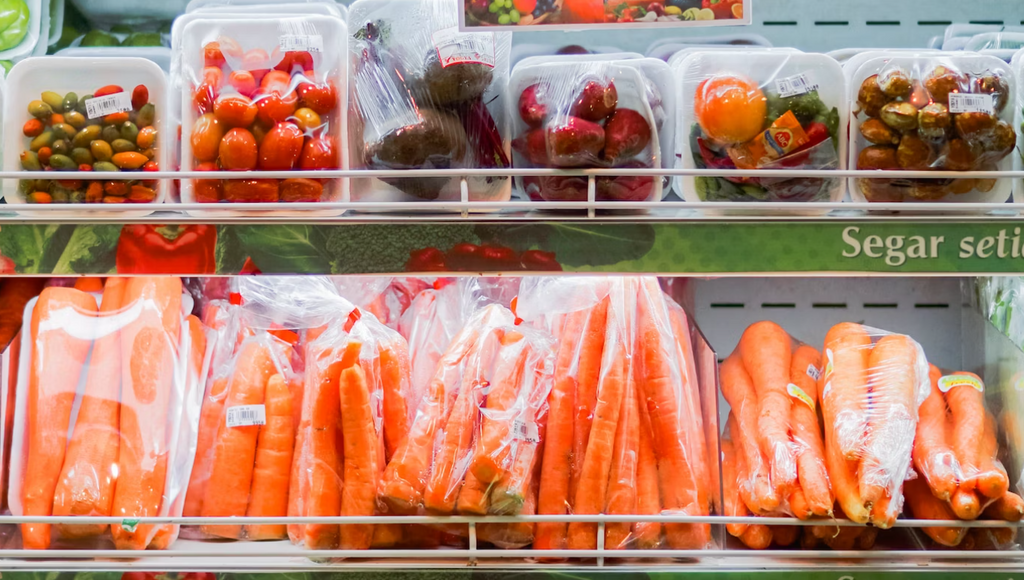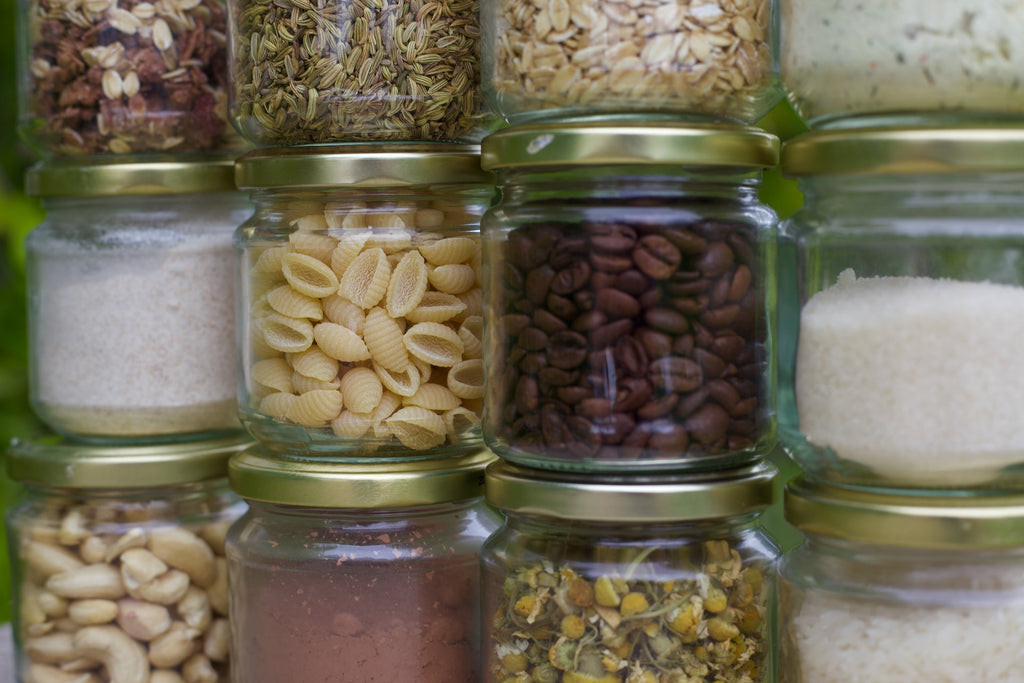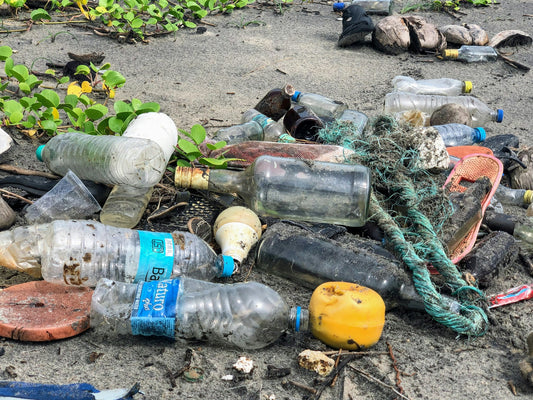Share
If you're looking for the perfect zero waste guide, this article is not for you.
We will rather share real-life tips that help you save plastic, while still being able to manage your daily routine.
No perfectionism, no exclusive and inaccessible zero waste stores, no double the price for reusable items.
Don't get us wrong. If you are managing do really live that zero waste life, we applaud you and you have our respect!
We just know that life happens sometimes and sometimes the best we can to is traying to limit the waste in every life situation.
We mostly shop in regular grocery stores ourselves because we do not have a car. Even in those regular stores, there are things you can do to save huge amounts of plastic, without a lot of extra effort.
Let's dive in and check out the tips for buying food with less plastic.
1. Planning Ahead Saves Plastic AND Money

Have you ever wondered, why grocery stores almost always start with the Produce, Deli, and Bakery sections?
Pre-packaged baby carrots with a dip, sliced fruits and veggies, and a variety of different prepped meals that are waiting for you right at the store entrance.
Usually that's paired with delicious scents of freshly baked goods and freshly cooked food.
The reason is simple: That's where stores make the most money.
Profit Margins for grocery retailers are tiny. If you buy regular items like eggs or rice, there is a good chance that the grocery store only makes 1-2% profit with that purchase.
For the prepackaged produce, deli and bakery sections that is a different story. Stores can hope for a margin of up to 40% if you buy a prepackaged meal.
That means you often pay double or triple the price than for buying the ingredients.
The additional downside: Most if not all of the prepackaged food in these early sections of the grocery store come in plastic containers.
Rather than hopping into the store when you need something, create a weekly shopping list and plan your meals ahead for the week.
Simply having that shopping list will prevent you from falling for the convenience trap that stores lay out for you.
This will not only save you money and tons of plastic. You'll also limit your microplastic exposure and set yourself up for a healthier life overall.
2. Buy Loose Produce Where You Can
Now that you have a plan and ditch the prepacked meals, it is time to buy the ingredients for whatever delicious meals you have planned.
It is very likely that you need some produce.
The good news is: Even the cheapest discount grocers now have an abundance of loose produce to choose from.
Especially "standard produce" like apples, peppers, bananas, or tomatoes, won't be hard to find loose.
Now the thing is: it's up to you to decide if and where you pack these fruits and veggies.
Way too often I see people bagging two tomatoes or a single pineapple in plastic bags. You can possibly convince me that you REALLY need that.
For the fruits and veggies that need bagging, reusable produce bags are a fantastic companion.

Bringing your own produce bags or simply not bagging produce at all will significantly reduce the amount of plastic waste you cause during grocery shopping.
3. Check Out Bulk Stores
Bulk stores are a great place for buying dry goods.
Just as with smaller produce, you can bring your own bags or containers and buy just the amount you need.
While there are certainly stores that ride the sustainability train and price bulk foods heavily, there are also cheap alternatives.
Doing some research will give you local options and set you up for less plastic in your life.
The good thing is: you won't have to visit multiple stores every time you go grocery shopping.
Again, planning is the trick. If you have the enough storage containers these dry goods will last a long time and it will be enough to stock them monthly (or even less often).
Why don't you try bringing muslin bags and your empty glass jars to a bulk store and try it our.

4. Buy Family Size
We understand that you may not always have the nerves to go to a bulk store just to get some spaghetti or rice.
Luckily, there are still ways to at least reduce the plastic waste in regular grocery stores.
And again it will even save you money, rather than cost more.
Let's say for example you choose XXL family pack rice. You will be able to save as much as 60% AND you'll reduce packaging waste by 50-60%.
5. Check for Alternative Packaging
Many products in the regular grocery store are available in non-plastic packaging. Aluminum cans, glasses, and paper or bamboo packaging are are all viable options.
While those packages are also not perfect, they are more easily recyclable and have a less detrimental impact on the environment.
Buying those products will send a message ("Vote with every dollar") and urge the grocers to stock up their alternatives.
If you're interested in a comparison between plastic and these alternatives, check out our deep dive blog articles.
6. Think About Reuse Opportunities
Whether or not your product comes in plastic or a more sustainable material, you can always think about reuse opportunities for the packaging.
I won't lie, there have definitely been times where we went grocery shopping and chose one product instead of the other because we could reuse the packaging better.
And the fun part is: It again saves you money.
Here are our some of the things we rarely buy anymore, because we reuse them from grocery shopping:
- Rubber bands
- Mason jars and other glass jars
- Garbage bags
- Organizers (egg cartons and yoghurt containers do the trick)
- Seeding flowerpots (plastic/aluminum container with holes)
Our friends from Earth911 created a great article that helps with additional inspiration here.
7. Buy At the Counter
If your grocer of choice has a cheese, baker, and butcher counter, those often use a lot less packaging than prepackaged food.
Cheese for example often comes in a single sheet of cheese paper.
The products from the counter can be a little pricier, but they are also often from local farmers or artisans and it may be well worth the extra dollar.
8. Bring Your Own Containers
If you want to go the extra mile, you can often bring your own container.
Just check with the clerk at the counter if that's possible.
Before COVID, most stores accepted you to bring Tupperware, zipper bags or other containers for meat, cheese and bread.
While many stores still have those restrictions in place, we've found that some (mostly locally owned) grocery stores are totally fine with it.
9. Know Your Hood
What the heck do we mean with that???
Well... things can be super different depending where you live.
Especially when it comes to recycling, reuse schemes, and deposit schemes, it makes sense to do a quick google search on your local guidelines.
Reuse schemes: If you're lucky, you can find initiatives from farmers markets or grocers in your area that offer refill stations for milk, yoghurt, honey or other essentials.
Deposit schemes: depending on your location you will be able to retur different packags for a deposit. While alcohol cans and bottles are accepted in most regions, other may even accept tetra paks, bottle lids, or drink bladders.
Recycling: while recycling should be the last resort, it is still better than buying non-recyclable packages. A quick search about your local guidelines will help.
As a rule of thumb for plastic, try to go with the recycling codes 1 or 2, which are the most recycled plastics worldwide.
Wanna learn more about how the plastic industry tricked us into believing recycling is the savior of the world? Check out this article.
We hope you enjoyed this article. If you want to read more like this, make sure to check out our Blog and follow us on Instagram. If you are interested in truly sustainable products, check out our Shop.
If you want to engage in the discussion, feel free to leave a comment below.









